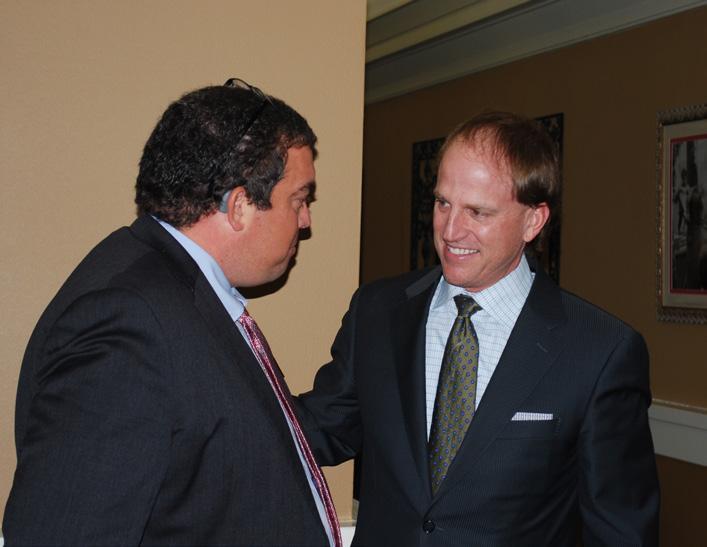
6 minute read
Washington Update
After a year of persistent, targeted advocacy by bankers, the final days of the 113th Congress came to a close with some modest yet strategically important victories for our industry. Building Momentum for the Year Ahead Just days after AmBA’s Government Relations Council Administrative Committee arrived in town to hammer out key priorities for 2015, lawmakers passed long-sought legislation that raises the asset threshold for small bank holding companies eligible for regulatory relief from $500 million to $1 billion. The small bank holding company relief bill — which for the first time applies to S&L holding companies, too — will make it easier for community banks and thrifts to issue debt and raise the capital needed to increase lending to local economies. Congress also passed a spending bill that included a repeal of a Dodd-Frank Act ruling related to derivatives trading. That represents the first successful legislation to revisit a DoddFrank provision that went too far and that even regulators admitted was unworkable. Together, the bills provide regulatory relief to banks small and large. But they were just two of a host of regulatory relief measures that AmBA and the state banking associations pursued this year. While the other measures didn’t cross the finish line, they advanced far enough — some even passing the full House — to position them well for action in the 114th Congress. These include bills that would: deem mortgage loans held in portfolio “qualified mortgages;” clarify the CFPB’s points-and-fees test; provide a way for banks in rural areas to appeal the CFPB’s “rural” designation; establish an independent ombudsman for exam appeals; and eliminate annual privacy notice requirements for banks that haven’t changed their privacy practices. Passing these bills early in the new Congress will be one of ABA’s top priorities in 2015. That was a loud-and-clear conclusion of the GRC Administrative Committee, which spent hours discussing the issues of greatest importance to banks. The committee members, who represent every state and institutions of all sizes and charters, agreed that the issues fall into a handful of strategic categories: Level Playing Field/Charter Choice. Citing the outdated tax advantages and mission creep of credit unions and the Farm Credit System, the committee recommended holding these institutions’ feet to the fire. It also recommended that AmBA pursue charter flexibility and capital options for savings institutions — while continuing efforts to fix the unfair impact Basel III capital rules and other rules have on Sub S banks. Impediments to Serving Customers. Bankers reiterated that overzealous regulation and costly compliance hurts consumers by inhibiting banks’ ability to meet their needs. Mortgage rules, Bank Secrecy Act reporting and complex capital requirements are just a few examples of regulations in need of simplification. Payments System. We must ensure that all participants — banks and nonbanks alike —abide by the same rules in order to protect consumers and discourage risk to the system. Cybersecurity and Data Breaches. The committee stressed that those responsible for a breach must be held liable for its costs. The members also stressed the importance of all parties sharing the same notification and data security standards as banks. More Appropriate Regulation. Given the heavy cost that ill-fitting regulation places on financial institutions — traditional community banks in particular — the group agreed that we need a new model for bank regulation. Specifically, rules should be fair and efficient, tailored to an institution’s risk and business model and arbitrary asset thresholds should be removed. The potential impact that each of these areas has on our industry’s competitive future is enormous. By working with AmBA and fellow bankers to distill the many challenges facing banks into those of greatest strategic importance, the GRC has helped create a blueprint for engagement in 2015. It’s a road map we will use in our advocacy efforts next year — as we build upon the advances made in the 113th Congress.
GOV. FRANK KEATING President & CEO American Bankers Association
January 2015 | The Arkansas Banker 9 PROFESSIONAL DEVELOPMENT | WEBINARS January 2015 | The Arkansas Banker ABA Webinars... Provide the option of training as many employees as you wish for one price, all from the convenient location of your home institution! For more information about ABA Webinars, log on to www.arkbankers.org or call 501.376.3741 Marketing & Advertising Compliance: The First UDAAP Hotspot January 29, 2015 10:00 am - 12:00 pm C & I Lending in Today’s Competitive Market: Part I January 30, 2015 1:30 p.m. – 3:30 p.m. Reviewing Collateral Files, Loan Doc: Part III February 02, 2015 1:30 p.m. – 3:30 p.m. The Fundamentals of Loan Pricing: Part II February 03, 2015 2:00 p.m. – 3:40 p.m. Excel Explained: Internal Control February 04, 2015 10:00 a.m. – 12:00 p.m. Anatomy of An IT Examination February 04, 2015 2:00 p.m. – 3:45 p.m. Health Savings Accounts February 05, 2015 1:30 p.m. – 3:30 p.m. Information Security 101 for Managers: Mastering the Basics February 05, 2015 2:00 p.m. – 3:45 p.m. Opening Accounts for Nonresident Aliens: New Rules February 06, 2015 10:00 a.m. – 12:00 p.m. C & I Lending in Today’s Competitive Market: Part II February 06, 2015 1:30 p.m. – 3:30 p.m. Developing Your Outsourced Third Party Management Program February 06, 2015 10:00 a.m. – 11:45 a.m. Leading the Prospecting Effort February 09, 2015 1:30 p.m. – 3:00 p.m. Advanced Financial Statement Analysis February 10, 2015 10:00 a.m. – 11:45 a.m. Common Mistakes in Mergers and Acquisitions February 11, 2015 2:00 p.m. – 3:30 p.m. Success By the Numbers: Eight Keys To Teller Excellence February 11, 2015 1:30 p.m. – 3:30 p.m. Forming and Using the Bank Holding Company To Create Value February 11, 2015 10:00 a.m. – 11:30 a.m. Right of Setoff February 12, 2015 10:00 a.m. – 12:00 p.m. BSA Series: Opening Accounts for Marijuana-Related Business February 13, 2015 10:00 a.m. – 12:00 p.m. Basic Cash Flow Analysis February 17, 2015 1:30 p.m. – 3:30 p.m. Commercial Real Estate Appraisals: Part I February 17, 2015 10:30 a.m. – 12:15 p.m. Commercial Real Estate Cash Flow: Part I February 17, 2015 8:30 a.m. – 10:15 a.m. Enterprise Risk and the ALCO Process: Part I February 17, 2015 2:00 p.m. – 3:45 p.m. Understanding the New Integrated Disclosure Rules February 17, 2015 1:30 p.m. – 3:30 p.m. Keys To Understanding Personal and Global Cash Flow: Part I February 17, 2015 1:00 p.m. – 2:45 p.m. Hot Technology and Security Concerns February 18, 2015 2:00 p.m. – 3:45 p.m. Designing a Compliant ALLL Reserve Methodology February 19, 2015 2:00 p.m. – 3:00 p.m. Seven Habits for Success at Supervising February 19, 2015 10:30 a.m. – 12:30 p.m. Commercial Real Estate Cash Flow: Part II February 24, 2015 8:30 a.m. – 10:15 a.m. Commercial Real Estate Appraisals: Part II February 24, 2015 10:30 a.m. – 12:15 p.m. Enterprise Risk and the ALCO Process: Part II February 24, 2015 2:00 p.m. – 3:45 p.m. Keys To Understanding Personal and Global Cash Flow: Part II February 24, 2015 1:00 p.m. – 2:45 p.m. Five Ways To Improve the Value of Your Organization February 25, 2015 10:00 a.m. – 11:30 a.m. Capital Planning in the Current Environment February 25, 2015 2:00 p.m. – 3:30 p.m. ALCO Fundamentals February 26, 2015 2:00 p.m. – 3:45 p.m. EMV: What Do Hackers Know and Why Should You Care? February 26, 2015 2:00 p.m. – 3:45 p.m. Legal Liabilities When Check Fraud Occurs February 26, 2015 10:00 a.m. – 12:00 p.m.









